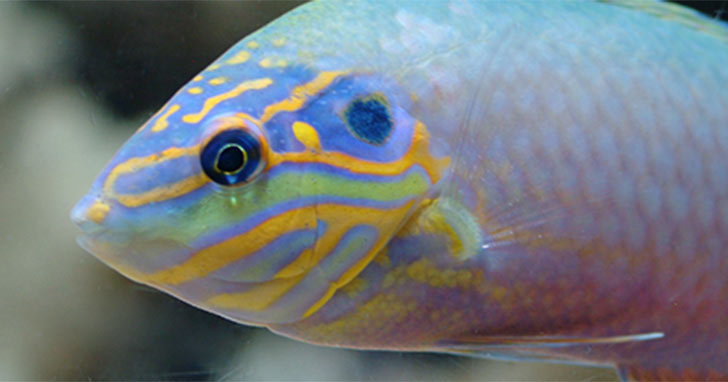
The ultimate reward for aquarists is to relax in front of their beautiful aquarium. In addition to its soothing effects, regular observation of your aquarium serves a vital purpose. Regular observation familiarizes you to "normal" aquarium conditions and provides important clues that alert you to any change.
This sensitivity to events that are out of the ordinary allows prompt action to any potential emergencies. Learn how to recognize and remedy out-of-the-ordinary events to ensure a properly functioning system with healthy inhabitants.
PROBLEM: Fish gasping at the surface.
POSSIBLE CAUSE: Lack of oxygen due to high water temperature or inadequate water circulation.
RECOMMENDED SOLUTION: Check aquarium water temperature. If water temperature is higher than normal, take action to lower water temperature. Turn off light fixture to reduce excess heat and open aquarium canopy to promote better air circulation. Use an air pump and airstone to aerate aquarium water. Another option is to put in a powerhead to improve aquarium water circulation and aeration.
PROBLEM: New aquarium fish not eating.
POSSIBLE CAUSE: Stress due to transport or acclimation in new living conditions.
RECOMMENDED SOLUTION: Test aquarium water parameters to ensure they are within an acceptable range for the particular fish you are keeping. Perform a partial water change if necessary to remedy water quality. To stimulate appetite, boost immune response, and encourage feeding, offer frozen foods such as brine shrimp, blood worms or mysis shrimp. To offer the best care, house new arrivals in a quarantine tank for individualized attention.
PROBLEM: Erratic swimming behavior combined with frayed fins.
POSSIBLE CAUSE: Ammonia spike or elevated levels of nitrogenous waste materials.
RECOMMENDED SOLUTION: Test aquarium water for ammonia and nitrite. If ammonia is present, perform a 25% water change to reduce toxic ammonia levels. Use an ammonia-neutralizing solution to provide immediate relief. Determine the cause of the ammonia spike (i.e., overstocking, overfeeding, or over-cleaning of aquarium gravel) and take corrective action.
PROBLEM: Power filter making excessive noise or rattling sound.
POSSIBLE CAUSE: Dirty impeller.
RECOMMENDED SOLUTION: Unplug power filter and carefully place it in a bucket. Follow manufacturer's maintenance guide and disassemble unit to access impeller. Check for organic or mineral buildup and clean impeller assembly and housing as per manufacturer's maintenance guide.
PROBLEM: A lot of air bubbles entering the aquarium via return pump in sump filtration system. Pump making loud gurgling sounds.
POSSIBLE CAUSE: Low water level in sump and submersible return pump is drawing in air.
RECOMMENDED SOLUTION: Check overflow box that transports aquarium water to the sump filtration system. A broken siphon in the overflow box will reduce or restrict water entering and filling the sump. Reestablish siphon to ensure proper water level in the sump filtration system.
PROBLEM: Presence of moisture near or around power filter.
POSSIBLE CAUSE: Clogged filter media restricting normal water flow and causing overflow.
RECOMMENDED SOLUTION: Carefully unplug filter from power source and clean filter media if reusable, otherwise, replace dirty media with a new media. Also, follow manufacturer's maintenance guide and dislodge any organic buildup within the intake tube. Clean the impeller assembly. Be sure to form a "drip loop" with the power cord after reassembling the filter and reconnecting to the power source. The drip loop should be formed using the power cord so it hangs below and away from the power outlet. This prevents water from traveling along the cord and coming into contact with the electrical receptacle. If there is any sign of abnormal water leakage, do not attempt repair. Contact manufacturer or consult an authorized service facility for service.
|
Aquarium Water Parameters |
PROBLEM: Low pH.
POSSIBLE CAUSE: Buildup of excess organic material creating an acidic environment.
RECOMMENDED SOLUTION: Incorporate regular gravel cleaning as part of your aquarium maintenance regimen. If necessary, use a buffering agent, as per manufacturer's recommendation, to gradually increase alkalinity. Be sure to test and monitor pH when taking any corrective steps. Any changes to aquarium pH should be done gradually to prevent shock. Since the pH scale is logarithmic, even a small change in pH means a drastic change in alkalinity or acidity.
PROBLEM: Proliferation of nuisance algae.
POSSIBLE CAUSE: Excess nutrients or aged lamp with weakened light output.
RECOMMENDED SOLUTION: Test for nitrate and phosphate. Elevated levels of these chemical compounds can encourage aggressive algae growth. Perform a partial water change to physically reduce these chemicals. Use a phosphate-removing filter media or a nitrate-removing filter media. Be sure to determine and remedy the source of these algae-fueling chemicals (i.e., overfeeding) for long-term resolution.
PROBLEM: Consistently high specific gravity in marine aquarium.
POSSIBLE CAUSE: Concentration of salt due to evaporation or top-offs with prepared saltwater rather than fresh water.
RECOMMENDED SOLUTION: Top off marine aquariums with conditioned tap water or reverse osmosis water. Prepared saltwater should only be used when performing water changes. Test salinity levels regularly.
|
Question:
How do I know if my fish are healthy? |
Answer:
In general, healthy fish are alert and active. They will have clear eyes, full stomachs and well-shaped fins that are in good condition. In addition, healthy fish will appear clean and colorful without unnatural spots or excess slime. Observe your aquarium daily to monitor the health of your aquarium inhabitants. |
PRODUCTS WE RECOMMEND
|